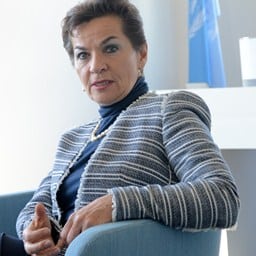
Stakeholders worldwide need to align their planning for both the best and worst-case temperature rise scenarios envisioned by the Paris Agreement, the United Nations’ top climate change official said Monday.
“The Paris Agreement, what it sets up is the possibility of a new reality, but it doesn’t guarantee that new reality. …. But now, the transformation needs to really occur, and it needs to occur in every sector,” according to Christiana Figueres, executive secretary of the U.N. Framework Convention on Climate Change (UNFCCC).
The accord, approved last December by nearly 200 nations at the 21st session of the Conference of the Parties to the UNFCCC (COP21), aims to curb global temperature increase in this century to “well below” 2 degrees Celsius above pre-industrial levels, but also offers the more ambitious target of a 1.5-degree spike.
The U.N. calls the lower target “a significantly safer defense line against the worst impacts of a changing climate.” Among the dangers of the 2-degree temperature increase over the lower goal are increasing sea level rise, lower crop yields, and longer heat waves, according to new research from Germany-based Climate Analytics.
On Friday, 174 nations and the European Union signed the Paris Agreement. However, it will not enter into force until ratified by at least 55 nations representing 55 percent of global greenhouse gas emissions. At latest count, 15 nations that produce 0.04 percent of global emissions had ratified the agreement, but top emitters China and the United States have signaled their intention to ratify this year. Figueres has said she believes the agreement will enter into force in 2018.
Governments at the national and subnational level, along with a broad swath of the private sector, should aim for actions in line with the 1.5-degree goal, but prepare for the impact of a world in which the temperature increases by 2 degrees, Figueres said.
“In our minds what we need to do is align everything, whatever institution we’re responsible for, whether we’re in a bank, or whether we’re in a corporation producing widgets, or whatever, we need to align ourselves from a mitigation perspective with the 1.5. Because that’s the one that is going to cut in and make this really transformational in the short term,” she said during a discussion at the Yale School of Forestry and Environmental Studies.
“And from an adaptation perceptive, of what we’re going to do to make ourselves more resilient, we have to align ourselves with the 2 degrees, because that’s the worst-case scenario, so we have to be ready for that,” Figueres added.
Climate experts note that the world’s temperature has already spiked by about 1 degree Celsius above pre-industrial levels, and the pledges made at COP21 will not enable nations to meet even the 2-degree goal, The New York Times reported last week. There are also any number of variables to the plan’s success, including energy companies’ and nations’ continued emphasis on fossil fuels, the outcome of the November U.S. presidential election, and the legal challenge against the Obama administration’s Clean Power Plan, which is central to its Paris Agreement pledge to reduce greenhouse gas emissions by 26-28 percent by 2025.
Speaking last week, U.S. Secretary of Energy Ernest Moniz said another “big step” in the climate change fight would be needed in 10-15 years, with even greater ambition in years after.
Figueres on Monday reaffirmed her belief that the Paris Agreement is not too little, but too late. “Had we reached this agreement 10 years ago, in 2005, we would still have had a decade and a bit to make the kinds of transformation, certainly in the financial sector and in the energy sector, that are necessary. We have really pushed our luck here, quite a bit.”
The UNFCCC chief, who after six years on the job is leaving her post in July, said it would be critical not to demonize any players now that work on the Paris Agreement has shifted from negotiations to implementation. In listing the qualities her yet-unchosen successor will need, she included “understanding that everybody’s position and interests are equally valid,” including states in which fossil fuels are a natural resource and companies that profit from exploiting fossil fuels.
“All of those will need our support as they transition into the new economy,” she said.